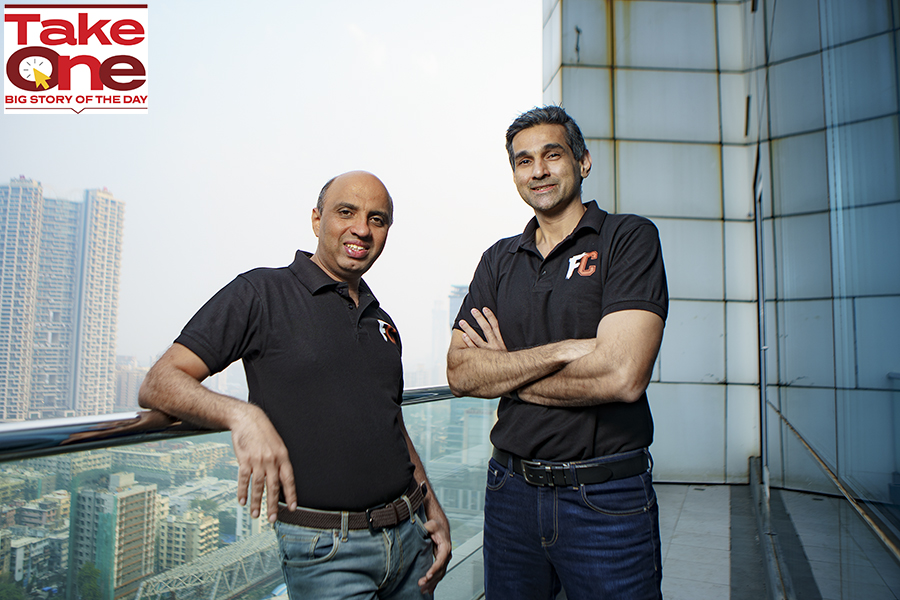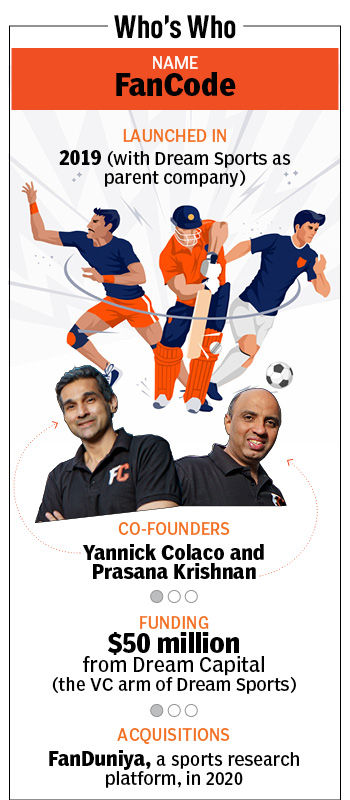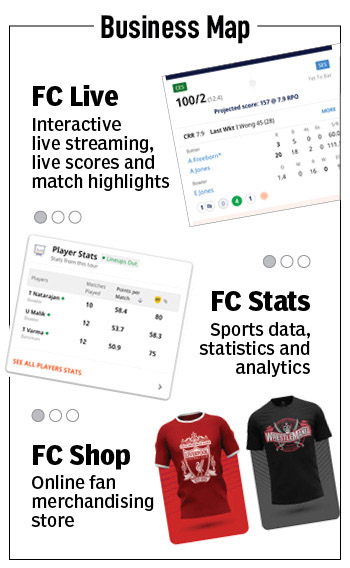How FanCode is building a one-stop destination for sports lovers
DREAM CAPITAL
Right at the entrance of its office in Mumbai, FanCode makes no bones about what it dabbles in—sports. Mounted on one of its walls at the reception is an enviable collection of autographed memorabilia—bats and jerseys signed by Indian Premier League (IPL) teams, a pair of gloves from South African keeper Quinton de Kock, what have you. On another is a floor-to-ceiling mosaic of key sporting moments—there’s Md Ali laying into his opponent with a right-hand jab, Kapil Dev and Mohinder Amarnath sharing a laugh with the Prudential World Cup, Roger Federer fist-pumping at Wimbledon, Neeraj Chopra flaunting his Olympic gold, Megan Rapinoe exulting with the World Cup, and many more. Our short wait to meet the founders fly by in an absorbing game of who’s-who, identifying each tile of sporting history.
And that’s exactly what the FanCode founders—Yannick Colaco and Prasana Krishnan—have set out to do: Build a digital destination for sports fans to lose themselves in. Replete with interactive live streaming (FC Live), sports data, analytics and statistics (FC Stats) and online fan merchandising store (FC Shop), FanCode wants to deliver a fan experience that’s immersive, personalised, 360-degree, and a paradigm shift from the linear services that traditional platforms offer.
“I am a Manchester United fan,” says Colaco, who has previously worked with sports broadcaster Nimbus. “Monday mornings for me begin with finding out when the club’s playing next, for which I have to go to the club website. When I want to watch the game, I have to go elsewhere. When I want to buy a club jersey, I have to go to an ecommerce site. There was no single platform which made it easy for fans to follow their favourite teams or players. That’s what we are looking to solve.”
Along with Colaco, Krishnan, too, had worked with Nimbus earlier, a role in which they believe they also contributed to the fragmented experiences for sports fans by offering linear viewing services. Colaco later moved on to the NBA and Krishnan to Sony Pictures Network India, from where they came together in 2019 to launch FanCode under the parent company of Dream Sports, which also owns fantasy sports platform Dream11. (Dream Sports, which ended FY21 with a revenue of Rs 2,706 crore and a profit of Rs 329 crore, as per data from Tofler, has helped FanCode scale up, but its multiple verticals operate independently, says Colaco.)
For FanCode, the idea was to build a sports business based on what a fan needs, as opposed to, as Krishnan says, “first building a service and then finding a user base for it”. In three years, FanCode has registered 50 million unique users across all platforms, while the app has seen 25 million downloads, 70 percent of those from non-metros, thereby democratising the sports-viewing experience and taking it beyond urban hubs. “We expect app downloads to climb 5x in the next one and a half year,” says Colaco. FanCode has also seen a 4-5x growth in both daily and monthly users from 2020 to 2021, and has streamed more than 300 events to date, covering 9,000-plus matches and over 42,000 hours of live content.
In its streaming bouquet, it has exclusive tie-ups with the West Indies, Afghanistan, Ireland and Zimbabwe cricket boards (meaning it has the rights to stream in India any domestic and international matches these countries play). Which means in July, FanCode will stream India’s tour of the West Indies, its biggest-ticket event so far.
That apart, it has tied up with the Bangladesh board for the Bangladesh Premier League, signed a four-year deal with the England and Wales Cricket Board (ECB) for the newly-minted league, The Hundred, ICC Pathway Events, the J League in football, Major League Baseball, and FIFA qualifiers for the African, North and Central American, and Caribbean regions, among others.
On the merchandising front, FanCode is the official partner for several sports leagues and teams, and also works with the official partners of other leagues and teams, enabling it to become the merchandise destination of outfits like the IPL franchises, the BCCI, NBA, WWE, and football clubs, including Liverpool and Borussia Dortmund. “We have over 30 brands and 800 products in the FanCode Shop. Both users and purchases are almost doubling every quarter,” says Krishnan.
In early 2021, FanCode raised $50 million in funding from Dream Capital, the corporate venture capital and M&A arm of its parent Dream Sports. Neither Krishnan nor Colaco are willing to divulge any further financial details, but both believe revenue is a product of creating value over the long term. Right now, FanCode’s monetisation avenues revolve around some of the premium content, and the store. “We monetise either directly from our users through content subscriptions or FC Shop, or indirectly through advertising solutions,” says Colaco.
The company’s focus, though, remains on creating different buckets for sports-loving consumers—amp up the watch-read-buy triumvirate so that it remains the go-to platform for anything sports. But with each vertical remaining a crowded space, it may not be an easy ride.
In India, streaming is a $1.3 billion industry today, says Raghav Anand, segment leader, digital media (Africa, India and Middle East), EY, which is expected to more than double to $3 billion by 2025. At present, it has about 500-odd million users, and the number is expected to go beyond 700 million in the next two to three years. Of these, there are 100-odd-million subscriptions that may go up to 150 million in five years. “In a price-conscious market like India,” says Anand, “Bollywood and sports have been the main levers in driving up subscriptions.” But it doesn’t come cheap.
Take the IPL media rights, for instance. A number of Indian broadcasters and global tech giants have picked up the tenders for the next IPL cycle, the media rights of which are expected to go for anywhere between Rs 45,000 crore and Rs 50,000 crore. While media reports say FanCode has also thrown its hat in the ring, the competition is expected to be fierce and the fees steep: The reserve price for the digital rights for the Indian subcontinent is pegged at Rs 12,210 crore for five years, according to The Economic Times.
“If a platform streams only smaller tournaments,” says Anand of EY, “and doesn’t have rights to bigger and more popular cricket and football leagues, that will limit their chances for customer acquisition. In the Indian landscape, 100-million-plus customers for AVOD (advertising-based video-on-demand), and 10-million-plus for subscriptions are considered the minimum requirements for a platform to be considered significant.”
While the company is tight-lipped about its IPL ambitions, Colaco and Krishnan insist they can chase scale not so much by going after a few marquee events, but aggregating multiple smaller events to give fans a wider choice—from, say, Kerala club cricket with Byju’s KCA Club Championship, to Cricket Ireland domestic league for both men and women, to Fairbreak Invitational, the recently-concluded high-octane women’s T20 tournament or even the Valletta Cup, a cricket tournament played in Malta. “Instead of looking at a single mega event, like an IPL, we’ve gone the route of saying let’s focus on the underserved Tier II and below events, and get 10,000 to 100,000 to a million and more fans to watch each of these. Cumulatively, this gives us tremendous ability to scale,” says Colaco.
Would a Jharkhand local league match or one from Caribbean domestic cricket, for instance, bring traction on their own? “Probably not. But what if we aggregate state after state in India, local league after local league internationally?” argues Krishnan. “Our strategy is to cater to fan requirements that exist but are unserviced. Often, there are a number of events that have been ignored because they won’t deliver the expected ROI (return on investment). That doesn’t mean the fan base doesn’t exist. That’s the market we are after.”
“Streaming will be one of the most critical aspects of sports content distribution. The combination of affordable data and smartphones has made the consumer today more connected and tech-savvy,” says Johnny Grave, CEO, Cricket West Indies.
“For any sports organisation, especially cricket, India is our biggest market, and an OTT platform provides access to a wealth of data and metrics that will help us to grow our audience by better understanding what works with them,” he adds, explaining the rationale behind tying up with a lesser-known broadcaster. With India’s tour of the West Indies lined up in July, Grave hopes FanCode will “deliver the great package”, like it had done during his nation’s tours of South Africa, Australia and Pakistan last summer.
Even for an event like the IPL that it doesn’t stream, adds Colaco, the platform provides in-depth coverage with live scores, data and analytics for the matches, customised for fans. A take on, say, why shouldn’t you have picked red-hot Dinesh Karthik in your fantasy team for Royal Challengers Bangalore’s match against Punjab Kings. “We have a significant amount of active users during this period as well,” he says. “We aren’t just a plain-vanilla OTT platform whose job is to distribute content.”
Besides, the platform is also trying to put out data feeds on players while a live match is on, enabling a viewer to access it with a click. In 2020, it acquired FanDuniya, a sports research platform, for an undisclosed amount to amp up its data analytics-statistics vertical. “As we continue to build these out, our monetisation channels will grow,” adds Krishnan.
In keeping with their motto of democratising the viewing experience by going beyond the metros, FanCode has also reduced the entry barriers for users willing to pay, thereby also looking to bring within its fold the value-conscious ‘next billion’. So, instead of selling locked-in monthly or annual subscriptions, it has brought in a sachet pricing that allows customers to watch as they please, either buying tour passes or those for individual matches, some for as low as Rs 4.
“Since its inception, FanCode has remained true to its ethos of democratising the journey of a sports fan. Dream Capital believes the fans want to consume personalised content and commerce and this platform is uniquely positioned to understand these needs,” says Dev Bajaj, who leads Dream Capital as the chief strategy officer of Dream Sports. “Our funding of $50 million will help the company in expanding their current offerings, deepening the engagement with fans and broadening their reach and user base.
Like FanCode’s scaling-up ambitions through streaming will be tested in a crowded, competitive Indian market, so will its attempt to take the fans closer to the teams through its other monetisable vertical: Merchandising. The licensed merchandising market is in a nascent state in the country, in contrast to the global market that’s on a growth trajectory. According to a Licensing International report in 2020, the global sales revenue generated by licenced sports merchandise amounted to $28.9 billion in 2019, while, in India, it was somewhere around $18 million. Reason: Quality, original merchandise remained prohibitively expensive for Indians who turned to affordable fakes instead.
But with the IPL teams pushing merchandise to add to their revenue, the markets might just open up in the near future. “Sponsorship or TV revenue keeps increasing, but they are at a stage where there’s no new innovation in the business. Whereas in merchandising, all IPL teams see a great scope for commercial, technical, marketing innovation,” says Vaibhav Dhar, head of marketing and content, Delhi Capitals (DC). And FanCode is looking to tap into the vast, unexplored mass market by offering them authentic merchandise at bargain rates—official IPL jerseys for under Rs 2,000, for instance.
Dhar adds that merchandising is DC’s top priority now. While sponsorship and media rights sell themselves, even in a bad year of ticketing, DC has seen over 95 percent of stadium attendance. “So where is the opportunity for growth? Merchandising. This is where platforms like FanCode come into the picture,” says Dhar.
FanCode, too, has expanded its store catalogue from mere merchandise to other sports gear, like football shoes, cricket bats etc. “It’s a one-step-at-a-time expansion, keeping in mind everything that a sports fan may need or ask for,” says Krishnan.
Says Anand of EY: “I believe the merchandise market will pick up, but it won’t be anywhere close to the Western markets for a long time. I don’t know how much of that market can Indian sports platforms leverage. But if they are able to get 100 million-plus fans on the network, there are enough ancillary opportunities for the sheer size. And this, being a sports community, might be their biggest play.”




